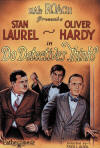|

 Convicted murderer Noah Young
escapes from prison, vowing vengeance on the judge (James Finlayson) who
sentenced him. Laurel & Hardy, inept employees of a private detective
agency, are assigned to guard him. Waylaying the judge's new butler, the
killer gets into his house in that guise. Prowling the house with huge
knives and swords, Young misses several opportunities to kill his intended
prey, and adds the detectives to his list of victims when they continually
get in his way. Eager only to avoid him, and by now totally unconcerned by
their mission to protect the judge, the boys do, by a fluke, capture him
after all and after turning him over to the law, leave, bowing modestly and
gracefully as they exit. Convicted murderer Noah Young
escapes from prison, vowing vengeance on the judge (James Finlayson) who
sentenced him. Laurel & Hardy, inept employees of a private detective
agency, are assigned to guard him. Waylaying the judge's new butler, the
killer gets into his house in that guise. Prowling the house with huge
knives and swords, Young misses several opportunities to kill his intended
prey, and adds the detectives to his list of victims when they continually
get in his way. Eager only to avoid him, and by now totally unconcerned by
their mission to protect the judge, the boys do, by a fluke, capture him
after all and after turning him over to the law, leave, bowing modestly and
gracefully as they exit.
The first film to present Laurel
& Hardy as the team we now know so well, it introduces them as
already-established workmates, clothes them in their traditional bowler hats
and rather shabby suits, and gives them their head to perform as though they
had been a team for years. Hardy is pompous, selfish, scared, a blusterer;
Laurel is well-meaning, dumb, equally scared, seldom aware of when he is
being used by his buddy. Several of their standard routines originate here,
including their many-times repeated exchange of hats (the hats are
continually dropped, picked up, passed from hand to hand, always resulting
in the wrong hat on the wrong head). Although a disappointing comedy, it is
an important one in that it offers their comedy style and screen
personalities in full fruition (albeit served by inferior material), the two
of them working together in perfect unison and harmony after only a handful
of trial balloons which had made no deliberate attempt to create such a
team.
The film is further helped by considerably upped production values—handsome
interior sets, a generous supply of crowd players in the opening courtroom
sequence, and first-class camerawork.
This latter is especially
apparent in a well-designed graveyard sequence (obviously shot at night and
not in the daytime with filters, as is the common practice) in which the
boys are scared by their own exaggerated shadows, which seem to clutch at
them from behind the tombstones. In escaping from the cemetery, the boys use
a treadmill to create an illusion of greater speed, the kind of mechanical
aid to a gag which they rarely found necessary thereafter.
In view of the added care that
went into the production of Do Detectives Think?, it is a pity that it isn't
nearly as good as one would like the first authentic Laurel & Hardy vehicle
to be. It contains entirely too much scared reaction comedy, running around,
pratfalls, and such old mechanical gags as a grotesque mask improbably
falling on to the back of the head of one of the participants (Finlayson)
while he is wearing a sheet, thus provoking much frenetic running around in
the belief that he is a genuine ghost. The best gags, other than the
carefully worked out graveyard sequence, are almost throwaways: Finlayson as
the judge, sentencing the fearsome killer to death and then, with a pop-eyed
grimace, adding, "And I hope you choke!"; Laurel pouncing on the struggling
figures of Hardy and the killer, and triumphantly placing the handcuffs on a
pair of hands that of course turn out to be Hardy's; and Laurel proudly
marching the finally subdued maniac into a closet, the briefly opened door
showing us the sudden realization and terror on the face of Hardy, hiding
within. Another worthwhile gag has Finlayson hiding submerged in the waters
of his bath, while the maniac prowls the bathroom searching for him.
Accidentally, Finlayson's foot removes the plug, and the water drains out—incidentally
leaving a spectacularly dirty ring around the bathtub!
Although this film was never
officially remade, many of the gags and specific situations in Do Detectives
Think? were reused by the comedians in later films, with Going Bye Bye being
the most obvious parallel. |
